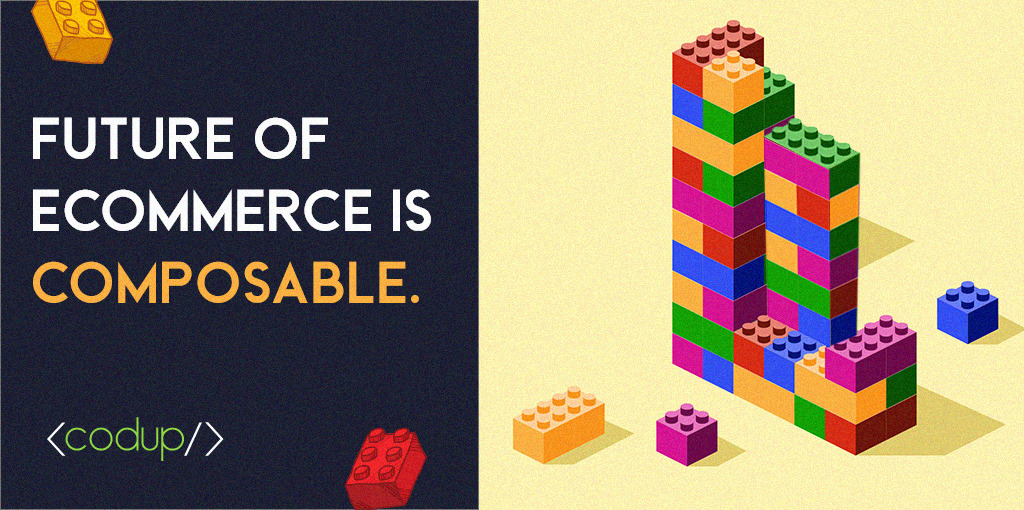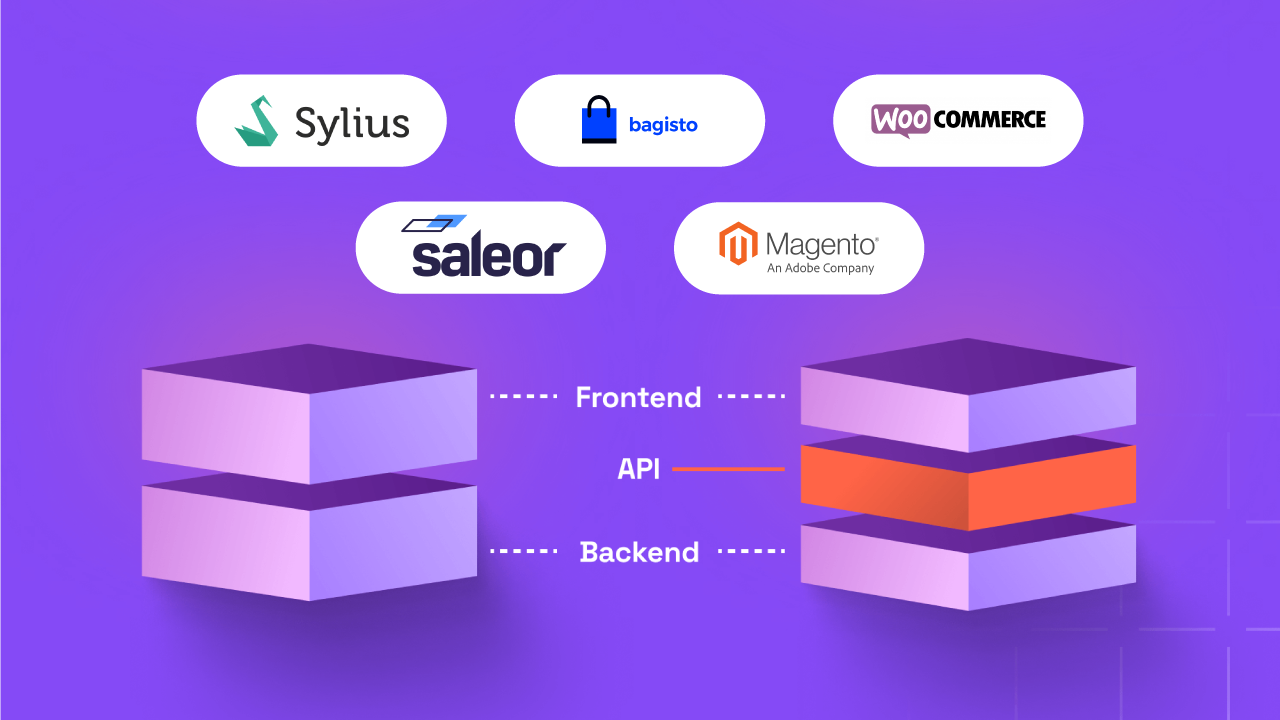Composable Commerce in Simple Terms – Is it Recommended for Your Business?

Composable Commerce is a new term that’s often thrown around by software development companies. But what is composable commerce and why do businesses need it?
Let’s start with laying down the foundation and explaining the need for a different eCommerce software architecture and then get into what benefits does the composable architecture provide.
The Need for Composable Commerce
Scalability has always been a major problem for eCommerce companies. As businesses grow their product lines and expand their customer base, they need an eCommerce platform that not only keeps up with their increasing demands but also gives them the flexibility to add new features that help them serve their customers better.
In 2019, Forrester research pointed out that 74% of businesses were concerned that their current platforms wouldn’t allow them to scale properly. 78% said their legacy solution couldn’t adequately support cross-channel order management. [Source]
While many software providers devised solutions, each building a more scalable platform than the other, in truth they were all the same and often forced their customers in a vendor-lock-in situation. The most viable solution was suggested by Gartner in 2020, popularized as composable commerce.
What is Composable Commerce
Composable commerce is a commonly used term for software architecture that separates the UI from the back-end providing the possibility to choose the best-of-breed eCommerce components and integrate them together, forming a custom application. It leverages modern tech and approaches like MACH and Jamstack to adapt to the changing market dynamics.
Consider this: a composable commerce shop might use different solutions for processing payments, another for shipping, and a different one to manage store subscriptions. Although all three modules are from different vendors, it is viewed and experienced as a single store by the customers. The software stack communicates via API, and the particular solutions can be replaced without impacting the other parts of the system.
The term “composable commerce” was first popularized by Gartner in a report in 2020, where it predicted that by 2023, businesses and enterprises that have adopted the composable approach will outrun their competition by 80% with the implementation of new features.
It stated: “With composable application approach, digital experiences can be assembled as required, depending on the customer and touchpoint requirements, and delivering an “eCommerce site” may just be one of these experiences’ types.”
Let’s look at the four tenets of composable commerce.
Key Tenets of Composable Commerce
1. Modular
Each component of the system — every module integrated with the system can be deployed and interchanged interdependently.
2. Open
Applications can be integrated seamlessly with all the other applications of the system with no vendor lock-in.
3. Flexible
With your unique stack, you can create a unique eCommerce experience tailored to what your customers require.
4. Business-centric
A fully customized system enables rapid response to the changing business landscape, making more things possible with fewer consequences, low cost, and increased innovation.
The Great Evolution
Considering that Composable commerce is a pretty recent development approach, enterprise and midmarket businesses built their eCommerce stores on a monolith architecture. In a monolith framework, all the necessary components of the platform are tied together. In simple terms, the front-end of the platform that can be seen by the customers is connected to the back-end that controls everything behind the scenes.
The Problem With Monoliths
While using an all-in-one platform is easy, but as brands grow, they begin to understand the problems of using a monolith architecture.
By definition, a monolith framework features a tightly tied front and back-end system. Speaking of customizations, it can only make the system more complex over time, especially when business capabilities grow and technology advances.
Complexity means that businesses are unable to respond to their customers as quickly. Simply said, a monolith system doesn’t provide the flexibility to make changes to the platform quickly without risking consequences.
Headless Commerce
Headless Commerce is the decoupling of the front-end of the platform from the back-end. Here, the front-end of a simple eCommerce website is the theme or a template that controls what the customer coming to the website sees.
That said, headless commerce offers more flexibility. It enables you to connect your system with different plugins and applications. What’s even better, you can easily customize the front end without affecting the essential eCommerce components like checkout or security.
Since it is easy to scale, it is easy to experiment with different options to make experiences. Decoupling the front and back-end also helps increase speed and flexibility, which is the first step to easy use of the website and making experiences.
Read More: Composable Commerce Vs. Headless Commerce: Is It All about Customer Experience?
MACH Architecture
So, in headless, some parts of the system are decoupled. But talking about a true microservices framework, the platform and service-oriented architecture are fully decoupled.
With microservices, businesses can combine individual services from various vendors to suit their needs. These individual components communicate via APIs for complex business transactions. And since they are individual components, they can also function individually. So, swapping a component out of the system will not impact any other pieces.
Composable Commerce
This modular approach aligns closely with the micro-services approach, but it separates the two approaches with merely a semantic difference: its emphasis on the packaged business capabilities (PBCs) over microservices.
PBCs are software components that represent defined business capabilities. They can be used as building blocks for applications and custom application experiences.
So, PBCs and micro-services are basically component-based and hook into the system the same way, but unlike micro-services, PBCs are not constrained by size. They can bring micro as well as macro capabilities.
Advantages of Composable Commerce
With the continuous Evolution of technology, retailers must find new ways and anticipate changing the customer experience to keep up with the growing competition. Composable Commerce is a modular approach that offers businesses the agility they need to deliver experiences at speed and outrun the growing number of competitors.
1. It Constructs A Personalized Customer Experience
The report by Gartner focused majorly on one thing: the customer journey. Customer touchpoints have shifted from in-store shopping experiences to online to social channels, marketplaces, and more. Shoppers’ interactions with brands in context and medium have drastically changed. Where before, the shopping experience started from content, today, it is happening from social platforms or from content. Customers prefer direct methods instead of an eCommerce marketplace. There are very less people starting from search.
That said, constructing a shopping experience requires flexibility on many levels, which was not required in the early days of eCommerce. However, doing all that personalization for customer experience pays off! How? Forbes states that as many as 60% of millennials say that they are loyal to a brand that offers unique shopping experiences.
2. Quick Response to Changing Business Needs
During the uncertain circumstances of COVID-19, only a few businesses were prepared to adjust to the changing needs and expectations of their customers.
It was the time to adapt to the situation and offer services such as Buy Online, Pick up in-store (BOPIS), to minimize close contact with in-person shopping and weather the pains of the pandemic. The fact is the use of BOPIS boosted by 195% year-over-year in May 2020 because of the pandemic.
Shifting the services in a monolith system may be difficult, but a modular, best-in-breed approach allows you to address the problem in functionality without impacting other business capabilities in your system.
3. No Vendor Lock-in
monolith software vendors reduce the client’s flexibility to change or tweak the software as per the changing requirements. It’s either waiting for the contract expiration or opting for a potentially expensive migration. Both options are a big no-no for companies, especially when customer buying behaviors are drastically changing. With the modular build, it is easy to swap an application with another when it makes sense for the business.
Disadvantages of Composable Commerce
The advantages of composable commerce explain why many enterprise-scale businesses are moving in its direction. However, every good thing also comes with its fair share of roadblocks and challenges that needs to be considered before heading straight with the choice.
1. Multiple Vendor Management
If there is one thing that’s good about monolith architecture, it is that you don’t have to deal with many vendors. Negotiating the terms of subscriptions, reviewing terms and conditions, and integrating them with the software takes time.
Service agreements are another aspect of the challenge.
2. Require High Digital Maturity Levels
Composable commerce is a complex model of software development that requires an organization. Jimmy Duvall, in his article at Forbes, explained micro-services as Lego blocks without an instruction manual directing to piece them together to build a platform that perfectly portrays the idea envisioned.
That said, it can be difficult and expensive to put together such a platform that creates a compelling and manageable customer experience.
3. A DIY Control Panel
The pure microservices or headless commerce experience requires a business owner to build an organized user interface stacking all components together. The tasks are made simpler by a more out-of-the-box platform, perhaps a control panel. However, it can sometimes be more difficult to manage.
Also, check out: Interview with Rick Watson : Headless vs Composable Commerce
When is Composable Commerce the Right Choice?
There are some things that need to be considered when choosing composable commerce. Down below are some questions that may help you to get the right answer!
– How important are optimal commerce experiences in the market? Is your market rapidly changing?
– Consider the complexity of your current infrastructure. To be the judge of that, maybe consider if you have to freeze all the deployments a month before Black Friday to avoid webpage breakdown?
– Can your architecture be scalable? Can it be changed as required?
– Are you dependent on an innovative solution for your long-term success? Does your current software architecture give you the flexibility and time-to-market that you need?

What Should You Consider When Choosing a Composable Commerce Platform?
To migrate from your monolith stack to composable commerce, you need to have a cost and time-effective approach. The best approach here is to start by replacing your front-end instead of re-platforming.
Doing this, of course, can be intimidating, but doing this on the right platform can help. It is true that with composable commerce, you’re not locked into a vendor, but the right eCommerce platform can make a big difference in the success of your store.
Here are some things that you must look for in a composable commerce solution.
- Quick and Easy Set-Up
As said above, combining and stacking a list of eCommerce application modules into a simple solution is not so simple. However, it doesn’t have to be difficult either. Here, the eCommerce platform you choose to build your store is the key to making this not-so-easy task not difficult either! You can simply set it up and start integrating components for a perfect solution. The best part, it is also easy to change and add more features once the basic version is deployed in the market.
- Flexibility
Flexibility is the key benefit of choosing composable commerce architecture. To ensure that you have flexibility and scalability, check the limitation on the number or type of applications you can add to your platform.
So, a platform that is good for your store mustn’t have limitations over the number or type of applications. Even if, in the very first version, you are not integrating many applications, you should be able to modify it later on if required.
- API-first
A platform that takes a product-centric approach to APIs is an API-first platform. You must understand that APIs are not just integrations but the products themselves.
An API-first platform focuses on API connectors from the start instead of creating software that fulfills particular business requirements and then tacking on APIs, making it compatible with the other services.
The advantage of an API-first is that APIs are reusable. So, all of the functionalities within your applications are accessible through APIs.
- Pricing
For many businesses, especially small to medium-sized businesses — their choice of an eCommerce platform boils down to cost. Naturally, they want their composable commerce solution to be cost-effective to be able to fit into their budget.
So, with a traditional model, you’d only have to pay the subscription fee. Some platforms base it on the monthly cost of your transactional volume, and some base it on the total revenue.
In addition to that, you also have to pay for the license of the third-party services. Depending on the platform that you choose, you can also be charged for implementation, support, and training fees. Make sure to consider all the costs before choosing the right solution.
- Customer Support
Good customer support is the most important aspect of a platform that must be considered before making a decision. Considering that your ecommerce solution consists of different modules from several vendors, you need to support relationships with all of them. However, sometimes the ecommerce platform only provides a single point of contact for you to deal with the issues related to PBCs.
Make sure you consider your approach to customer support for your multi-vendor solution before making a decision about your choice of platform.
Learn more about your approach to building a perfect solution by talking to our experts. We can turn the idea you envisioned into a reality!
You can rely on us for top-notch eCommerce Development Services. CODUP have recently been awarded with a badge of “Top B2B Companies Global 2022” from Clutch.




